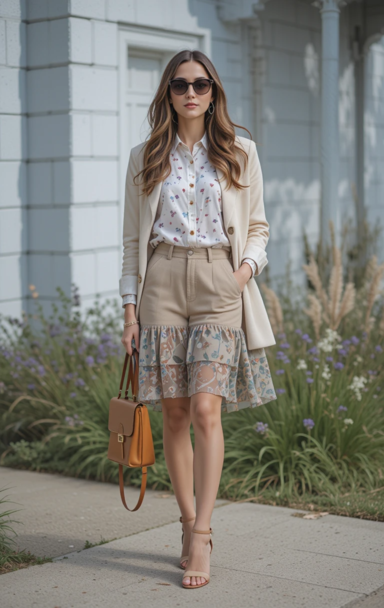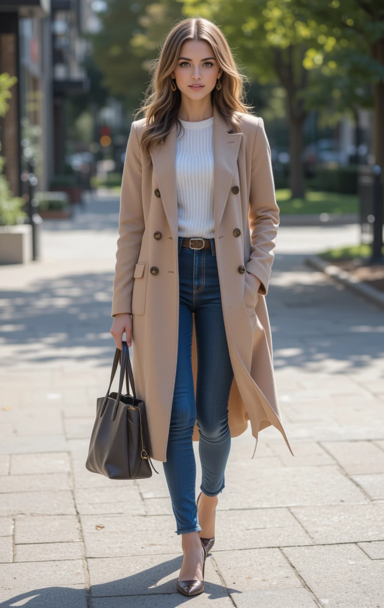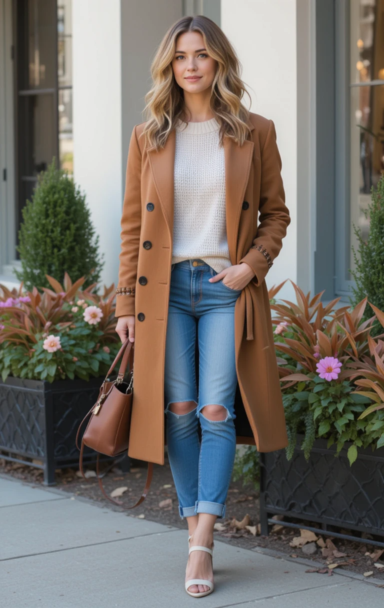Effortlessly Chic: How to Master the Art of Transitional Dressing for Every Season
Transitioning from one season to another can be one of the most challenging and exciting times for a fashion enthusiast. The weather is unpredictable, and it can be difficult to know how to layer, what fabrics to choose, or how to balance comfort and style. However, mastering the art of transitional dressing allows you to stay stylish throughout the year while embracing the changing weather conditions. Whether it’s shifting from winter to spring, or summer to fall, with the right approach and a little creativity, you can effortlessly pull off chic looks that work for every season.
In this article, we’ll break down how to navigate the tricky waters of transitional dressing while maintaining a sense of personal style. We’ll focus on key strategies, versatile pieces, and styling tips that will help you look put together no matter the time of year.
Understanding Transitional Dressing
Transitional dressing refers to the art of choosing outfits that can carry you through changing temperatures while remaining appropriate for the season’s vibe. These outfits typically involve layering pieces that can be added or removed as the day progresses, making them perfect for the fluctuating temperatures associated with spring and fall. By selecting the right materials, colors, and silhouettes, you can transition seamlessly between seasons.
Key characteristics of transitional dressing include:
- Layering: Layering is the backbone of transitional dressing. It allows you to be prepared for any temperature fluctuations, whether it’s a chilly morning turning into a warmer afternoon or vice versa.
- Versatile Pieces: Transitional outfits rely heavily on pieces that can be dressed up or down, layered, or mixed and matched. A great pair of jeans, a classic jacket, or a neutral top can go a long way.
- Neutral Palettes: While bold colors can be fun, neutral colors such as beige, white, gray, and navy make it easier to mix and match pieces from different seasons.
- Adaptable Fabrics: Fabrics play a big role in transitional dressing. Lightweight yet warm materials like cashmere, wool-blends, and cotton are ideal. You’ll also want fabrics that are breathable but can still offer warmth, such as denim, knitwear, and light leather.
With these core principles in mind, let’s dive into how to master transitional dressing for each season.
1. Spring to Summer: Embrace Lighter Layers
As the days get longer and the temperatures rise, it’s time to start shedding the heavy coats and scarves in favor of more breathable and light layers. However, the mornings and evenings can still have a slight chill, making the early part of the day feel cool. Here’s how to make the transition from spring to summer seamlessly:
Key Pieces to Include:
- Lightweight Jackets: A trench coat or a stylish denim jacket is perfect for the early mornings or evenings when the weather is still a bit brisk. A tailored blazer is also an excellent choice if you want to maintain a polished look.
- Maxi Dresses: A flowy maxi dress offers the perfect balance of comfort and style. Pair it with a light cardigan or a casual jacket for early spring days, and ditch the layers as the weather warms.
- Loose Blouses: Choose a lightweight blouse in cotton or linen. These fabrics breathe easily but still provide coverage in the mornings. Roll up the sleeves for added versatility.
- Chinos or Cropped Trousers: Swap out the heavier winter pants for chinos or cropped trousers in breathable fabrics. These pants work well for both the warmth of summer and the remaining spring chill.
Style Tips:
- Play with Colors: Spring and summer call for a pop of color. Pastels or earthy tones like soft blush, sage green, and dusty blue can add vibrancy to your wardrobe without feeling overwhelming.
- Shoe Choice: Transition from boots to sandals or mules, but keep a pair of chic sneakers handy for comfort on those long days.
- Accessories: Sunglasses, scarves, and light scarves can elevate your look and serve as both functional and fashionable pieces.
2. Summer to Fall: Perfect the Art of Layering
The shift from summer to fall is often marked by sudden temperature changes. The weather can still be warm during the day, but as evening approaches, the chill of fall sets in. This transitional period is about layering effectively, keeping comfort in mind, but also embracing autumn colors and textures.
Key Pieces to Include:
- Sweaters and Cardigans: A chunky knit sweater or a cardigan can be thrown over a t-shirt or a blouse for an easy look. It’s perfect when the air cools, but the sun is still shining.
- Denim Jackets: Denim jackets are ideal for transitioning from summer to fall. They’re versatile enough to be worn over dresses or paired with jeans and can easily be layered with a scarf or vest for added warmth.
- Boots: Ankle boots are a great addition for autumn. They pair beautifully with skirts, dresses, or jeans and add an edgy touch to any outfit.
- Midi Skirts and Dresses: Midi skirts and dresses work for both warm and cool temperatures. They can be worn with sandals during warmer days or boots as temperatures drop.
Style Tips:
- Layer in Style: Try layering with a vest, a lightweight leather jacket, or a stylish blazer. These layers offer warmth but keep the look sophisticated.
- Autumn Colors: Autumn is the season for rich colors. Think deep burgundies, mustard yellows, forest greens, and burnt oranges. Incorporate these hues into your wardrobe for a seasonal feel without looking overdone.
- Hats and Scarves: Autumn is the perfect time to experiment with hats like fedoras or berets. Scarves, both light and chunky, also provide warmth and visual interest.
3. Fall to Winter: Cozy Chic
When the leaves start to fall and winter’s chill sets in, it’s time to fully embrace cozy, layered outfits. However, winter dressing doesn’t have to mean sacrificing style. The key to a chic winter wardrobe is in investing in quality, classic pieces that can keep you warm while looking sophisticated.
Key Pieces to Include:
- Overcoats and Puffer Jackets: Whether it’s a classic wool overcoat or a trendy puffer jacket, investing in a quality coat is crucial for both style and warmth.
- Turtlenecks and Knits: Turtlenecks offer a sleek and chic option for cold weather, and they layer well under jackets, blazers, and coats. Cashmere or wool blends will keep you warm without being bulky.
- Heavy-duty Boots: Opt for knee-high boots or stylish ankle boots made of leather or suede. Look for boots with insulation to keep your feet warm without sacrificing style.
- Tights and Leggings: As temperatures plummet, tights and leggings become essential. Pair them with skirts, dresses, or under trousers for added warmth.
Style Tips:
- Play with Layers: Start with a thermal or base layer, add a turtleneck or blouse, then top off with a stylish coat. Layering textures and colors can add dimension to your winter outfit.
- Winter Accessories: Knit beanies, gloves, and scarves are a must. Choose them in neutrals or bold colors to brighten up the dreary winter months.
- Mix Textures: Pair a wool coat with leather boots or a cashmere sweater with denim for a mix of textures that keeps things interesting.
4. Winter to Spring: Lighten Up Without Losing Warmth
The transition from winter to spring can be unpredictable, with lingering cold mornings followed by warmer afternoons. This period calls for an expert balance between warmth and breathable fabrics.
Key Pieces to Include:
- Light Wool Coats: Instead of heavy winter coats, opt for a medium-weight wool coat or a lightweight trench coat that’s perfect for layering over springtime outfits.
- Cashmere Sweaters: Soft and warm, cashmere sweaters can be worn with skirts, jeans, or under jackets. They provide insulation but are light enough for spring.
- Floral Dresses or Skirts: As the temperatures rise, opt for floral prints that feel fresh and light. Layer them with tights and boots for chillier days, or let them shine once the weather warms up.
- Boots and Sneakers: Swap out winter boots for ankle boots or transitional shoes like loafers or sneakers. They offer the perfect combination of style and comfort.
Style Tips:
- Incorporate Bright Colors: Spring is the time to introduce brighter, lighter colors such as pastels, lavender, and soft greens. However, be mindful not to fully abandon the cozy tones of winter.
- Layer Smartly: A trench coat over a thin sweater or blouse with a pair of jeans is the ideal outfit for this season. Be sure to have accessories like scarves or shawls at hand for those unpredictable chilly mornings.
Conclusion: Mastering Transitional Dressing
The art of transitional dressing revolves around strategic layering, the choice of versatile and timeless pieces, and a deep understanding of fabric and texture. Whether you’re moving from winter to spring or fall to summer, the key to achieving effortlessly chic looks lies in mixing and matching key pieces, focusing on adaptability, and ensuring that you’re prepared for the ever-changing weather.
As you move through the seasons, remember that transitional dressing is not only about surviving the weather but thriving in it. By incorporating the right fabrics, mastering layering, and investing in a few key versatile pieces, you’ll be able to transition through each season looking chic and feeling comfortable. So, embrace the seasonal shifts with confidence and style—after all, each new season is an opportunity to reinvent your wardrobe.

















